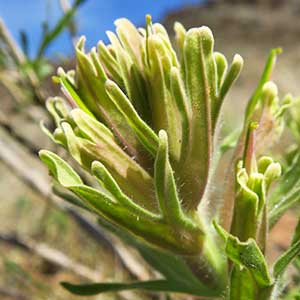Castilleja xanthotricha
Castilleja indivisa
John Day or yellow-hairy paintbrush, John Day paintbrush, yellow hair paintbrush, yellow-hair Indian paintbrush
entireleaf Indian paintbrush, Texas paintbrush
few to several, ± decumbent to erect or ascending, unbranched, sometimes with short, leafy axillary shoots, hairs erect to spreading, long, soft, eglandular, mixed with short stipitate-glandular ones.
solitary or few, erect, unbranched or 1–4 branches from proximal 1/2, hairs spreading, long, soft, often mixed with shorter stipitate-glandular ones.
green, linear, lanceolate to broadly lanceolate, oblong, or cuneate, 0.8–5 cm, not fleshy, margins plane to wavy, involute, 0–5-lobed, apex acute, sometimes rounded;
lobes spreading, linear, arising below mid length, nearly as broad as center lobe, apex acute.
green, not forming a distinct basal rosette, sometimes relatively dense proximally with short internodes, similar in size and shape to more distal cauline leaves, narrowly lanceolate to linear-lanceolate, (1.5–)2–8(–9) cm, not fleshy, margins wavy, sometimes plane, involute, 0(–5)-lobed, apex acute;
lobes erect, linear or filiform to narrowly lanceolate, apex acute to acuminate.
3–14 × 1.5–4.5 cm;
bracts proximally greenish, rarely dull reddish purple, distally white to cream, rarely pale yellow or dull, pale pink (sharply differentiated from proximal coloration), lanceolate or oblong to narrowly ovate, (3–)5–7-lobed;
lobes ascending, linear to obovate, ± broadened distally, medium, long, proximal lobes arising below mid length, central lobe apex broadly rounded to truncate, others acute to rounded.
2–16(–20) × 3–5.5 cm;
bracts proximally greenish, distally scarlet or bright red, sometimes deep to pale pink, peach, yellow, white, or magenta, sometimes with a white to rarely yellow medial band between green and brightly colored distal portion, proximal narrowly lanceolate, distal shorter and oblong-obovate, broadly obovate, or obtrullate, 0(–5)-lobed;
lobes erect or ascending, triangular, short, arising above mid length, proximal bract apex acute, distal obtuse, rounded, or truncate.
curved, 17–23 mm;
tube 15–19 mm;
beak exserted, adaxially green, 5–8(–9) mm, puberulent, stipitate-glandular;
abaxial lip deep purple (color sometimes visible through calyx), green, pinkish, or pale yellow, ± prominent, slightly inflated, usually hidden in calyx, sometimes right at top of calyx, 2 mm, ca. 50% as long as beak;
teeth ascending, whitish, yellowish, pink, or green, 1–1.5 mm.
curved in proximal 1/3, 15–29 mm;
tube 2–3.5 mm;
whole corolla included or beak partly exserted, abaxial lip included;
beak adaxially green, yellow, or pink, 4–10 mm;
abaxial lip green, white, or yellow, reduced, pouches 3, 2 mm, 25–30% as long as beak;
teeth erect, green, white, or yellow, 0.5 mm.
colored as bracts, 15–26 mm;
abaxial and adaxial clefts 3.5–7 mm, 25–50% of calyx length, deeper than laterals, lateral 2–5 mm, 12–25% of calyx length;
lobes linear, oblong, or narrowly triangular, center lobe apex usually rounded, lobes acute to rounded.
proximally light green, distally red, pale pink, or white, rarely pale yellow, usually paler than bracts, often with a white to yellow medial band between green and brightly colored distal portion, 16–31 mm;
abaxial and adaxial clefts 6–10 mm, 25–33% of calyx length, deeper than laterals, lateral 0(–0.2) mm, 0(–4)% of calyx length;
lobes expanded distally, apices much wider than narrow calyx tube, apex rounded, truncate, or emarginate.
= 48.
= 24.
Castilleja xanthotricha
Castilleja indivisa
Castilleja xanthotricha is endemic to moderate elevations in the sagebrush hills of the John Day River drainage in north-central Oregon. N. H. Holmgren (1971) hypothesized that this tetraploid species is of allopolyploid hybrid origin between C. glandulifera and C. oresbia.
(Discussion copyrighted by Flora of North America; reprinted with permission.)
Castilleja indivisa is native in Texas and adjacent states. In Mexico it is rare, with collections only from two states; these are likely waifs. This species is possibly extirpated from Arkansas. Records from Alabama (starting in 1995) and Florida (starting in 1961) are adventive populations, often on roadsides, and in some cases spreading from ornamental highway plantings. Castilleja indivisa usually has bright red bract apices and red, white, or pale pink calyx apices, but many color variants are found in nature and in cultivation, including individuals with the distal portion of the bracts colored white, pink, pale yellow, peach, or, very rarely, magenta. Uniformly white-bracted populations occur on the margins of tidal salt marshes in a small area of Nueces County, Texas, between Aransas Pass and Port Aransas. These populations likely deserve nomenclatural recognition, due to their combination of consistent coloration and unique habitat. While the main bloom period is in the spring, summer rains often allow continuing or renewed flowering during virtually any month of the year. Occasionally, plants show variation in leaf lobing; this likely reflects introgression from the C. purpurea complex, at least in some cases, such as in Coleman and McCullough counties, Texas.
(Discussion copyrighted by Flora of North America; reprinted with permission.)


